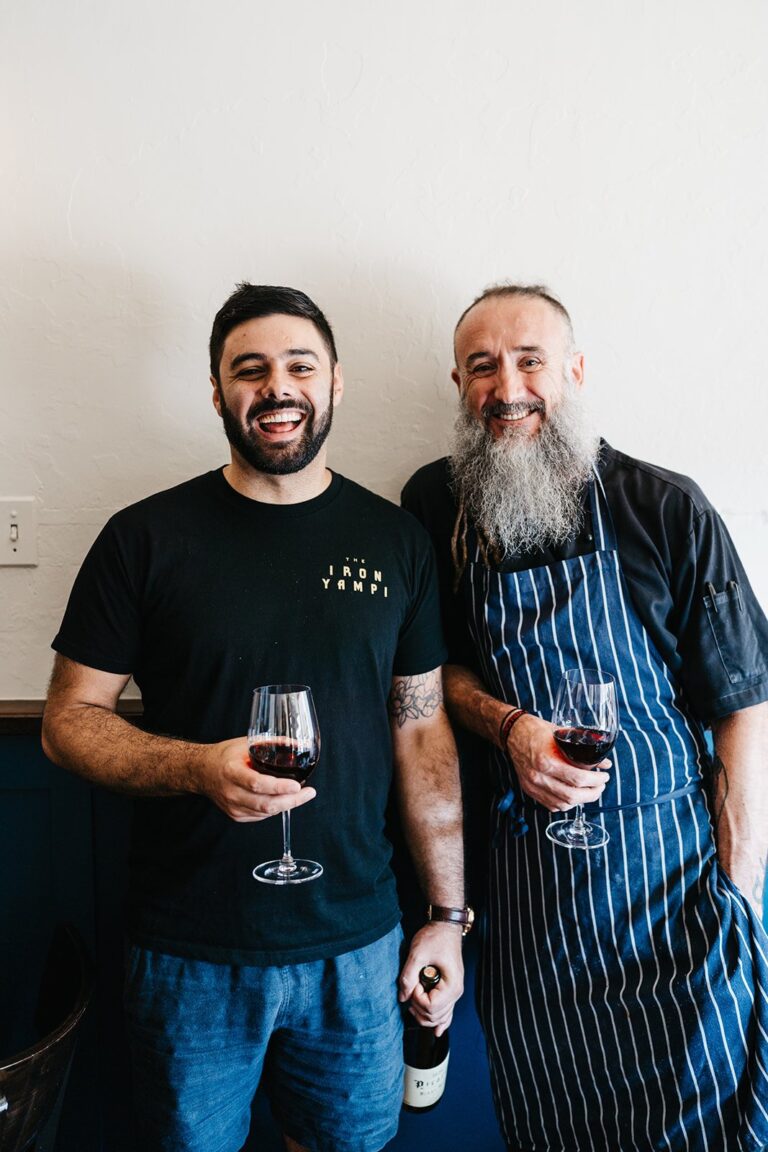In 2016, young chefs Tom and Simon bought Caveau and gave it a new heartbeat
A fine dining institution in the Illawarra since the doors first opened in 2005, Caveau has received a Good Food Guide Chef’s Hat for every one of its 13 years. In December 2016, Tom Chiumento, 28, who started his career in Wollongong before joining Caveau in 2014, and Simon Evans, 30, who had worked as a chef there since moving from Wales five years earlier, bought the Keira Street local and gave it a new heartbeat.
Having worked side-by-side at the stove for years, Tom and Simon were confident they could maintain Caveau’s legacy, bring a new energy to the well-respected eatery… and have a good time while making it happen.
“We knew we could open something without tearing each other’s heads off,” Simon laughs. “We have separate strengths and weaknesses,” Tom adds. “We don’t really overlap, and everything gets done.” Not only does it get done, but it gets done exceptionally well.
Simon and Tom have a created a space that’s elegant yet unpretentious. While you’re snacking on bread baked from house-milled flour and sipping a Semillon from Coolongatta Estate in the Shoalhaven, the bluesy sounds of The Black Keys, Ray Charles and The Alabama Shakes seep through the speakers.
The restaurant is welcoming and warm, and most nights you’re likely to see Tom or Simon bringing dishes straight to the table to explain how each ingredient has been thoughtfully used. As it should be, the food is the brightest light, but it is buoyed by the professional yet relaxed service, the impressive wine list and the creative and passionate chefs at the helm.
Their seven-course tasting seasonal menu really showcases what the chefs can do, and three days a week, they also offer a five-course choice menu (at only $85 – a steal!), where you’ll experience dishes like magpie goose ham, kangaroo cooked over coals, and Iced Vovo served with Killalea Farm strawberries. The boys’ ethos is local, homegrown and sustainable – food that is presented as edible art, consciously sourced and cooked with intention.
A meal at Caveau is one you won’t quickly forget. It’s fine dining without the faff, fine dining that doesn’t take itself too seriously… fine dining at its best.
We sat down with Simon and Tom to talk local produce, native ingredients and the Wollongong food scene…
How did buying Caveau come about?
Tom: Funny day that one. We’d been talking about doing something together for a while. Not necessarily a restaurant, but a pop-up. Then we approached Nicola [former owner] about doing our own dinner and she said, “Yeah for sure, but actually, while I’ve got you, do you guys want to buy Caveau?” So, I called Simon…
Simon: No, you texted me cryptically saying, Come into work, I’ve got something to tell you. And I thought ‘What are you on about?’ Obviously, we jumped at it – we were ready to take that next step. It was quite rushed, that was September and we were supposed to take over in December. And organise the millions other things to take over a restaurant. It was a full-on time. T: It was crazy.
So what changes did you make straight up?
S: We had our own ideas, but we were wary of how much could we do straightaway without losing the existing clientele, because if you’re buying an existing restaurant, you’re buying that reputation.
T: We had a timeline of where Caveau was and where we wanted it to be. And we thought that would happen in 18 months, but it ended up happening in about six. You can’t fake who you are. S: The food changed straightaway to our style, and that’s evolved more over time. We also changed the structure of the menu, the way we do service… even the music. In the first few months, some people didn’t like the music, saying it didn’t suit the style of the restaurant.
T: There’s a stigma behind fine dining – what it’s supposed to be – but that’s not necessarily what it is anymore. No-one really wants to go out and have their chair pulled out for them.
S: For us, it’s about picking the best of fine dining, but getting rid of any sort of pomp.
Your wine list has also evolved and it’s impressive!
S: It’s a juggle! We use up to 20 different suppliers and buy quite a few direct from wineries. We wanted to go more local with the food and that translated to the wine list also. At the last count, out of the 100 wines, 33 of them are from NSW. That’s where we want it. They’re all mainly organic, bio-dynamic practices, low-intervention winemaking, small wineries, some cult classics – we’re really happy with the offering now.
You’re very focussed on locally sourced ingredients, and you also grow your own produce?
T: That’s right, Harry grows our produce for us at Dapto Community Farm, and we have a few Styrofoam boxes growing veggies and herbs in the kitchen as well.
S: We plan out with Harry what we want to grow with him for the next menu to the specs, size and shape… it’s great to have that control.
Is that the process of setting up the menu?
T: We plan the whole year of seasonal plant food with Harry. So we go, “January to March, what’s in season?” And then Harry will plant those ingredients so they’re ready for us in time.
And any excess goes to the Flame-tree Co-op or we pickle it… there’s never any waste.
S: Harry is always six steps ahead of us. We often go on what he’s suggesting to plant – and say, “Well, that sounds interesting”, and then come up with something later.
Does that seasonality translate to the rest of your menu too?
S: In spring, we’ll always have lamb on the menu, because it’s at its best. Things like beef don’t really have seasonality to it, so you can use it all the time. But then there are native ingredients like magpie goose, which we’d probably spend six months trying to get hold of.
How do you get hold of ingredients like that?
T: There’s a company called Something Wild, who has a license to catch magpie geese, and they’re predominately owned by Indigenous people. They’re our non-local ingredients supplier. All the staples – beef, lamb, duck, eggs, dairy, we get locally.
S: If a supplier is doing something more sustainably in Victoria, then we’ll explore that. Local doesn’t always mean better, but we do our best to source the best from the local area.
It’s so important to cook with these native ingredients, because not many people in Australia have tried them. Why did you choose to use them?
T: We want to be the restaurant you come to if you want to experience the food of Wollongong. We want to not only use local ingredients but take inspiration from the local area. Going down that path, the Indigenous culture in Wollongong is very prevalent so using Indigenous ingredients makes sense. Wollongong is such an environmentally diverse place. We’re five minutes from the beach and the escarpment – that kind of change is pretty rare, so our scope of ingredients is quite large.
How do you learn how to cook with native ingredients?
S: You certainly don’t get taught in Wales! You’ve got to just look at things and use the knowledge you have to work it out. But there are some unique ingredients. As soon as we heard about the Illawarra plum, we thought what a perfect fruit for a restaurant in Wollongong.
T: And then we ate one… and it was horrible! It’s so bitter. The disappointment was huge – we’d thought, ‘What could be better? It’s a native, it’s named after our region’. But you just have to think outside the box. It’s not a bad ingredient, we just had to find its worth. S: It ended up being quite versatile when we worked it out – we’ve used it in desserts, main courses, we glaze the duck it in now. It’s all experimentation. T: We did a kangaroo jerky with pickled Illawarra plum. One of the great things about being a chef in Australia is we don’t have a national cuisine, which is awesome because there are no boundaries.
The Illawarra food scene has changed a lot over the last few years…
S: We’re definitely being taken more seriously as a food destination. But it can only get better, and it takes a population to expand to be able to have more restaurants and more diversity of restaurants. There’s some legit good restaurants here now, great casual dining, great coffee everywhere you go. I think people would now come to Wollongong and not want for anything.
What’s next for Caveau?
T: We want to take things to next level in terms of local produce. Driving our suppliers to do more, and as much as they push us to be better, pushing them to be better too.
S: We’re always thinking about how we can refine what we’re doing. We also realise for us to get better, Wollongong has to progress as well, so we’re focussed on trying to show people Wollongong as much as we’re trying to showcase Caveau.
T: We’re super passionate about Wollongong. I’ve grown up here. I love the place. More people should appreciate the balance of life we have here.
It’s refreshing to see chefs who are passionate about food, and also just having a good time…
S: We both have the same passion and the same drive, but we don’t take it too seriously. We’re not here to be shouty chefs, we’re here to enjoy it.
T: At the end of the day, it’s just cooking dinner. Of course, a lot of time and thought goes into it but we cook dinner for a living – it’s not open-heart surgery. It’s got to be fun.
data-animation-override>
“We want to be the restaurant you come to if you want to experience the food of Wollongong. We want to not only use local ingredients but take inspiration from the local area”


We’d love to send you occassional news and updates of happenings along the Coal Coast to your inbox!
We acknowledge the Traditional Custodians of the Dharawal Country. We pay respect to Elders past, present and emerging. The original storytellers.

Proudly funded by the NSW Government
© Coal Coast Magazine 2024. All rights reserved.
We’d love to send updates of happenings along our Coal Coast to your inbox!